
Easter, also called Pascha or Resurrection Sunday, is a Christian festival and cultural holiday commemorating the resurrection of Jesus from the dead, described in the New Testament as having occurred on the third day of his burial following his crucifixion by the Romans at Calvary c. 30 AD. It is the culmination of the Passion of Jesus Christ, preceded by Lent, a 40-day period of fasting, prayer, and penance.

Palm Sunday is the Christian moveable feast that falls on the Sunday before Easter. The feast commemorates Christ's triumphal entry into Jerusalem, an event mentioned in each of the four canonical Gospels. Its name originates from the palm branches waved by the crowd to greet and honor Jesus Christ as he entered the city. Palm Sunday marks the first day of Holy Week; in Western Christianity, this is the beginning of the last week of the solemn season of Lent, preceding Eastertide, while in Eastern Christianity, Holy Week commences after the conclusion of Great Lent.

Trick-or-treating is a traditional Halloween custom for children and adults in some countries. During the evening of Halloween, on October 31, people in costumes travel from house to house, asking for treats with the phrase "trick or treat". The "treat" is some form of confectionery, usually candy/sweets, although in some cultures money is given instead. The "trick" refers to a threat, usually idle, to perform mischief on the resident(s) or their property if no treat is given. Some people signal that they are willing to hand out treats by putting up Halloween decorations outside their doors; houses may also leave their porch lights on as a universal indicator that they have candy; some simply leave treats available on their porches for the children to take freely, on the honor system.
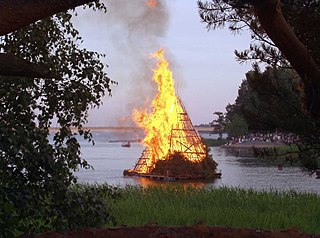
A bonfire is a large and controlled outdoor fire, used either for informal disposal of burnable waste material or as part of a celebration.

Shrove Tuesday is the final day of Shrovetide, marking the end of pre-Lent. Lent begins the following day with Ash Wednesday. Shrove Tuesday is observed in many Christian countries through participating in confession; the ritual burning of the previous year's Holy Week palms; finalizing one's Lenten sacrifice; as well as eating pancakes and other sweets.

Ash Wednesday is a holy day of prayer and fasting in many Western Christian denominations. It is preceded by Shrove Tuesday and marks the first day of Lent, the six weeks of penitence before Easter.

Holy Week is the most sacred week in the liturgical year in Christianity. For all Christian traditions, it is a moveable observance. In Eastern Christianity, which also calls it Great Week, it is the week following Great Lent and Lazarus Saturday, starting on the evening of Palm Sunday and concluding on the evening of Great Saturday. In Western Christianity, Holy Week is the sixth and last week of Lent, beginning with Palm Sunday and concluding on Holy Saturday.
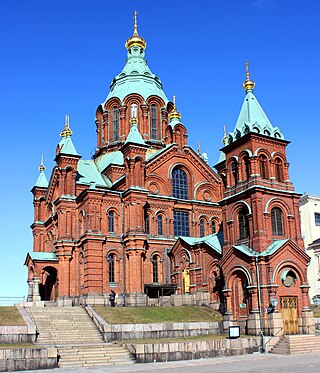
The culture of Finland combines indigenous heritage, as represented for example by the country's national languages Finnish and Swedish, and the sauna, with common Nordic and European cultural aspects. Because of its history and geographic location, Finland has been influenced by the adjacent areas, various Finnic and Baltic peoples as well as the former dominant powers of Sweden and Russia. Finnish culture is built upon the relatively ascetic environmental realities, traditional livelihoods, and heritage of egalitarianism and the traditionally widespread ideal of self-sufficiency.

Egg rolling, or an Easter egg roll is a traditional game played with eggs at Easter. Different nations have different versions of the game, usually played with hard-boiled, decorated eggs.

Pussy willow is a name given to many of the smaller species of the genus Salix when their furry catkins are young in early spring. These species include :
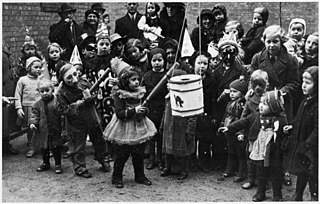
Fastelavn is a Carnival tradition in the Northern European, and historically Lutheran, nations of Denmark, Norway, Sweden, Latvia, Estonia, Iceland, Faroe Islands, as well as Greenland.
Easter is one of the most significant events in the religious and social calendar, celebrated heavily in the European country of Malta.

Easter traditions are customs and practices that are followed in various cultures and communities around the world to celebrate Easter, which is the central feast in Christianity, commemorating the resurrection of Jesus. The Easter season is seen as a time of celebration and feasting, in contrast to the antecedent season of Lent, which is a time of penitence and fasting.

Czech folklore is the folk tradition which has developed among the Czech people over a number of centuries. Czech folklore was influenced by a mix of Christian and pagan customs. Nowadays it is preserved and kept alive by various folklore ensembles uniting members of all ages, from children to seniors, showing their talent during competitions, folklore festivals or other performances.
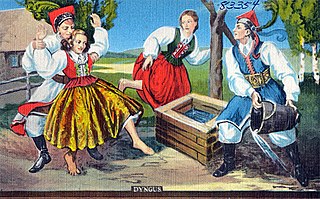
Śmigus-dyngus or lany poniedziałek is a celebration held on Easter Monday across Central Europe, and in small parts of Eastern and Southern Europe. The tradition is widely associated with Poland in English-speaking countries and is observed by Polish diaspora communities, particularly among Polish Americans who call it Dyngus Day. The tradition is also deeply rooted in Hungary.

An Easter palm is a traditional Lithuanian and Polish symbolic decoration associated with Palm Sunday. Barbara Ogrodowska states that the ceremonial palm branch is the "most important attribute" of Palm Sunday in Poland. Communities of Polish emigrants, such as those in the United States, observe the tradition of making of Easter palms as well.

Śmiergust is a long-standing folk custom popular in some parts of Poland, particularly in and around the town of Wilamowice. During śmiergust young men are dousing young unmarried women with water. The celebrations take place on the Market Square of Wilamowice on Wet Monday, and in or near the women's homes on Easter Sunday. Śmiergust participants are groups of dressed-up men, wearing special patchwork costumes.

The Carnival of Satriano, held in Satriano di Lucania, Italy every February, is one of the country's many carnivals. Held on the Friday, Saturday and Sunday before Fat Tuesday, it has been conducted for centuries. The event is among the most important carnival traditions of the region and of Italy and it is unique in that participants wear costumes, or masks, of bears, hermits, or lent.

Juha Tapio Vuorinen is a Finnish writer, columnist and radio personality. He is best known for his five-volume book series The Hangover Diaries, particularly the first volume Totally Smashed!. Since 1983, Vuorinen had been working as a reporter for radio and television, a director, a screenwriter and a producer.
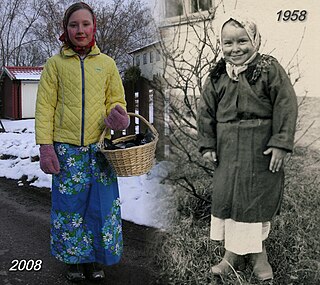
Easter witches is an old Swedish legend about witches flying to Blockula on brooms on the Thursday before Easter or on the night between the Wednesday and Thursday before, and returning on Easter. In modern times children dress up as witches, old ladies or in old men's clothing and go door to door distributing greetings and often receiving treats in return.





















